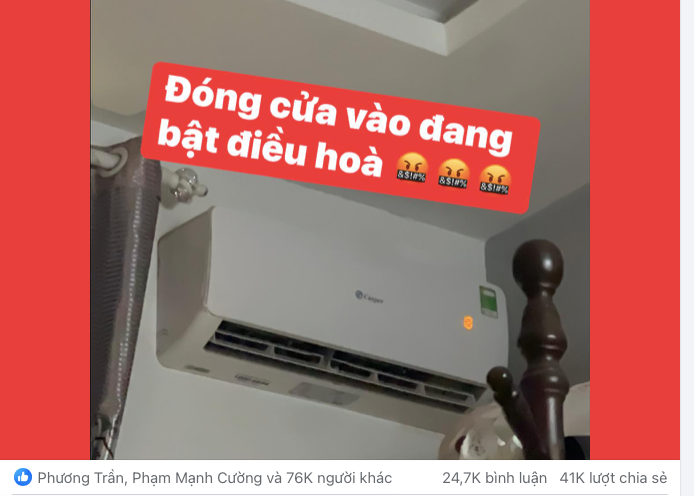Article about fatigue, headaches, even hair loss due to CO concentration 2 The increase in air conditioning usage in closed rooms is being shared on social networks. (Screenshot) |
The post by account Đ.HV received more than 76,000 likes and tens of thousands of shares in just two days, with the warning: “Air conditioning doesn’t kill anyone, but ignorance can!”
Mr. D.HV shared that he often turned on the air conditioner and closed the door when sleeping. As a result, he constantly woke up feeling tired, had a severe headache, and had a fast heartbeat. Suspecting that the problem was related to air quality, he used a CO2 meter and discovered that the CO2 concentration in the room was up to 2,000 ppm - far exceeding the safe threshold (below 700 ppm).
According to him, prolonged high CO2 concentrations can cause fatigue, reduced alertness, affect sleep and overall health, especially in young children and the elderly.
What do the experts say?
Dr. Nguyen Hong Vu explained that air conditioning only cools the air, does not consume oxygen or create CO 2. CO 2 mainly comes from human respiration. In a closed room, CO 2 gradually accumulates if there is no ventilation, at a rate that depends on the number of people, the area of the room and the time of sleep.
For example, a 20m², 3m high room (total 60m³), 1 person sleeping for 8 hours produces about 120-160 liters of CO 2 . If the room is completely sealed, the CO 2 concentration can reach ~2,666 ppm after 8 hours. But in reality, CO 2 often escapes through the door gap, so this level is difficult to reach.
According to the US Occupational Safety and Health Administration (OSHA), a safe concentration of CO 2 for 8 hours is below 5,000 ppm (0.5%). A level of 40,000 ppm (4%) is immediately life-threatening. However, at the threshold of 2,000-5,000 ppm, CO 2 can cause fatigue, mild headaches, and decreased concentration, especially upon waking. However, there is no scientific evidence that CO 2 at this level causes hair loss or suffocation.
Doctor Nguyen Huy Hoang (Vietnam-Russia High Pressure Oxygen Center) cited research from the Technical University of Denmark on safe CO2 thresholds saying: Below 750 ppm: Does not affect sleep.
750-1,150 ppm: Poor ventilation, sleep begins to suffer.
Above 1,150 ppm: Sleep quality is significantly reduced.
From 2,600 ppm: Causes sleep disturbances and reduced cognitive performance.
A study in Singapore showed that closed bedrooms using air conditioning often have CO2 concentrations of 1,500-1,900 ppm, even exceeding 2,000 ppm, leading to fatigue, difficulty concentrating and reduced performance the next day.
Experts recommend that people do not need to be afraid when using air conditioners, but should apply effective ventilation measures:
- Create ventilation slots: Make small slots (5-10 cm²) in windows or main doors, near the ceiling, to let CO2 escape naturally due to pressure difference.
- Open the door slightly and use a small fan: Open the door 0.5-1 cm, place a small fan facing the gap to draw fresh air in and push CO2 out .
- Use ventilation fans: Install convection fans or small ventilation fans high on the wall or ceiling, low capacity but high efficiency, little impact on air conditioner power.
- Air conditioner maintenance: Clean the filter and condenser every 6 months to avoid dust and mold. Ensure the humidity in the room is at 40-60% and limit placing green plants at night.
Source: https://baoquocte.vn/vi-sao-co-the-met-moi-stress-rung-toc-vao-mua-he-314694.html




![[Photo] Party and State leaders visit former President Tran Duc Luong](https://vphoto.vietnam.vn/thumb/1200x675/vietnam/resource/IMAGE/2025/5/24/960db9b19102400e8df68d5a6caadcf6)
![[Photo] Ho Chi Minh City holds funeral for former President Tran Duc Luong](https://vphoto.vietnam.vn/thumb/1200x675/vietnam/resource/IMAGE/2025/5/24/9c1858ebd3d04170b6cef2e6bcb2019e)





























































































Comment (0)